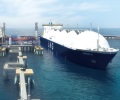

Despite around half of Australia’s population contending with the threat of entering July under lockdown, the country’s gasoline imports are expected to increase in the second half of the year, industry sources told S&P Global Platts.
Although the road to recovery remains bumpy as several states imposed snap COVID-19 related restrictions in the last week of June and vaccination rates remain slow, the country has been fairly successful in controlling the transmission of infections, the sources said.
Queensland became the latest state in Australia to impose a lockdown June 29 after recording a handful of cases of community transmission, joining New South Wales, Western Australia and the Northern Territory.
“Compared to the Southeast Asian lockdowns, Australia’s lockdowns seem to be quite short term. Cases are still generally low. Once the cases come down again, we would see demand picking up,” a market source said June 29.
Another industry source said: “The overall impact is not as great as the lockdowns [in 2020], but it still capped demand recovery.”
Driving activity in Australia declined to a five-month low in May of nearly 20% below baseline levels when a coronavirus resurgence prompted a lockdown in Victoria, swinging from around 30% above baseline levels in early April when the country was largely free of stringent movement restrictions, mobility data from Apple showed.
“Australia’s gasoline demand recovery has been bumpy due to the outbreak of COVID-19 from time to time, and lockdown has been implemented again in Sydney, which will dampen demand,” JY Lim, advisor oil markets at S&P Global Platts Analytics, said June 28.
“Overall, we expect to see gasoline [demand] growing by 10% this year, but still down by 4% when compared to pre-COVID levels,” he added.
Australia’s gasoline imports fell 5.5% month on month to 4.453 million barrels in April, latest data from the country’s Department of Industry, Science, Energy and Resources showed.
The department in its latest Resources and Energy quarterly report said Australian oil consumption was estimated to have fallen in fiscal 2020-21 (July-June) as COVID-19 containment measures weighed on activity in the latter half of 2020.
However, consumption was showing signs of recovery in 2021, with petrol and diesel consumption comparable to 2019 levels, the department said in the report.
There was an uptick in refinery throughput in the first six months of 2021, but it was forecast to decline over the full 2020–21 fiscal year, it added.
Refinery closures
BP and ExxonMobil have announced the closures of the Kwinana and Altona refineries, respectively, leaving Australia with only two operating refineries — Viva Energy’s 128,000 b/d Geelong and 109,000 b/d Lytton refineries — and increasing the country’s reliance on refined product imports.
The department forecasts Australia’s refined product imports to rise from 655,000 b/d in fiscal 2020-21 to 806,000 b/d in 2021-22 and 825,000 b/d in 2022-23.
“The closure of the half of the Australian refineries can be seen as beneficial to the last two refineries, helping to keep them open for longer,” another industry source said.
The Australian government in late June approved legislation to provide a lifeline to the two remaining refineries. The Fuel Security Bill 2021 will provide around A$1.8 billion ($1.34 billion) in funding to the two remaining refineries through the boosting of domestic stock levels of gasoline, gasoil and jet fuel.
The move is designed to provide material support during periods of low refining margins, Viva Energy Australia said in a statement May 26, adding the support package includes a significant contribution to upgrade the Geelong refinery to improve fuel standards.
Vaccination rollout
Australia’s GDP rose 1.8% in the January-March quarter, reflecting a recovery in the labor market after extended lockdowns in 2020, the Australian Bureau of Statistics said June 2.
Hotels, cafes and restaurants, recreation and culture and transport services continued to rebound as movement and trading restrictions eased in the quarter, it added.
Still, the country needs to accelerate the pace of its vaccination rollout to allow greater mobility and boost transport fuel demand, market sources said.
Around 7.5 million vaccine doses had been administered to Australia’s population of around 25.69 million as of June 28, according to the Australian Department of Health website. Less than 4% of the population had been fully vaccinated as of June 29, according to local media reports.
Source: Platts